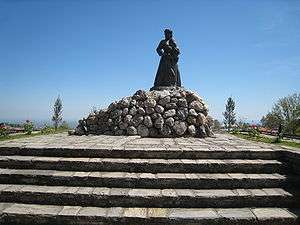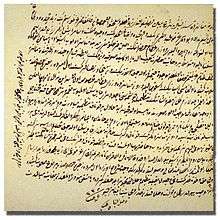Naousa massacre
| Naousa Massacre | |||||||
|---|---|---|---|---|---|---|---|
| Part of the Greek War of Independence | |||||||
 Memorial of the massacre in Naoussa | |||||||
| |||||||
| Belligerents | |||||||
|
|
| ||||||
| Commanders and leaders | |||||||
|
Zafeirakis Theodosiou Anastasios Karatasos Angelis Gatsos | Ebu Lubut | ||||||
| Strength | |||||||
| 4.000-5.000 soldiers | 20.000 soldiers | ||||||
| Casualties and losses | |||||||
| 2.000 | |||||||
The Massacre of Naoussa or Destruction of Naoussa was a bloody event of the Greek War of Independence that occurred on 13 April 1822.
Events before the siege
Plans for the upcoming revolution had already begun in the region long before its outbreak, so the Ottomans decided to take measures to prevent it. In January,1821 the wali of Thessaloniki Ebu Lubut imprisoned members of some of the most important families of West Macedonia. Some, however, like the "warband" leaders Anastasios Karatasos and Angelis Gatsos and also the notable Zafeirakis Theodosiou refused to surrender themselves to Ottoman authorities. After the arrests they gathered in a church and declared revolution against the Ottoman rule. This group ultimately marshaled 1,800 people to strike back as a rebellion, Veroia, but the attack failed when Ottoman reinforcements arrived.

The siege
Ebu Lubut then led the attack against Naoussa, at the head of 20,000 men. The city was defended by 4,000-5,000 Greek rebels. On 26 March Ebu Lubut requested that the rebels give up and let the Turkish forces occupy the city. The Ottomans began an organised siege at the beginning of April with multiple forces attacking the city. On April 12 the Turkish bombarded the city and destroyed the gates, capturing the city.